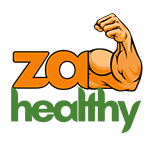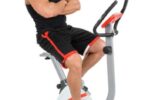Introduction
Welcome to the ultimate guide to leg workouts! Whether you want to build strength, enhance endurance, or sculpt your lower body, this blog is your go-to resource. Get ready to dive into a comprehensive routine that targets every muscle in your legs, from your powerful glutes to your sturdy calves.
The Foundation: Front Squat Grip
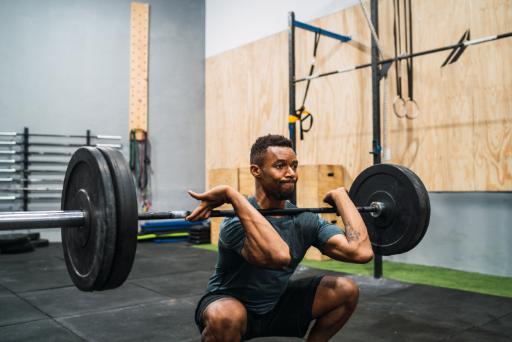
The front squat grip is a quintessential exercise for developing quad strength and overall lower body power. The front squat grip is crucial as it ensures proper form and safety. By keeping the elbows high and the bar resting on the shoulders, you engage the core and maintain an upright posture throughout the movement.
The Front Squat Grip refers to how you hold the barbell during a front squat exercise. There are three main grips:
- Rack Position (Clean Grip): The barbell rests on the front of the shoulders and along the collar bone area, with elbows elevated and fingers underneath the barbell pushing into your shoulders to maintain the bar’s position.
- Cross-Grip: Arms are crossed with hands placed on the bar at the opposite shoulders. This grip can help if you have wrist or shoulder mobility issues.
- Strap or Towel Hold: Using straps or a towel looped around the bar where your hands normally go, you grip the straps or towel to assist your grip, which can be helpful if you have difficulty with the other grips due to mobility issues.
Each front squat grip has its advantages and is chosen based on individual comfort, mobility, and the level of experience with the exercise. The ultimate goal for many is to master the Rack Position as it’s commonly used in Olympic lifting.
Seated Leg Press : Your Versatile Ally
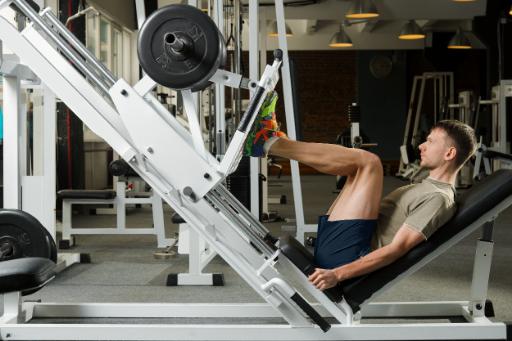
The seated leg press machine is a versatile tool in your leg-building arsenal. Seated leg press allows for heavy lifting without the balance requirements of squats, making it perfect for beginners and seasoned athletes. Seated leg press is a safe way to push past plateaus and keep gains coming.
The Seated Leg Press is a strength exercise that targets the quadriceps, hamstrings, glutes, and calves. Here’s how to perform it:
- Adjust the Machine: Set the seat so that your knees are at least at a 90-degree angle when you sit down.
- Foot Placement: Place your feet on the platform about shoulder-width apart and at chest height.
- Execution: Press through the heels to extend your legs with your back flat against the seat and grasping the handles. Avoid locking your knees at the top of the movement.
- Return: Slowly return to the starting position without fully resting the weight.
The seated leg press exercise can be beneficial for building lower body strength and can be adjusted to emphasize different muscles by changing foot placement.
Reverse the Ordinary: Reverse Hack Squat
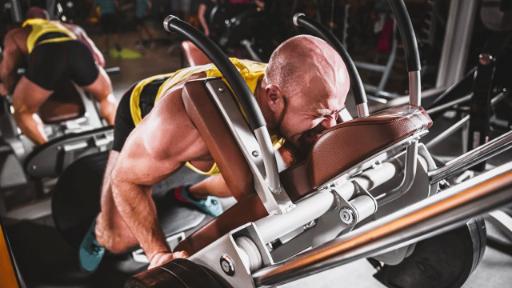
Take your squats to the next level with the reverse hack squat . This variation puts a unique twist on the traditional squat by flipping your stance, emphasizing the hamstrings and glutes. It’s a game-changer for those looking to round out their leg day routine.
The Reverse Hack Squat is a variation of the traditional hack squat that targets the lower body muscles, particularly the quadriceps, glutes, and hamstrings. Here’s how to perform it:
- Load the Machine: Start by loading a comfortable amount of weight onto the reverse hack squat machine.
- Position Yourself: Stand on the foot platform with your chest facing the support pad.
- Shoulder Placement: Place your shoulders underneath the shoulder-cushioning pads.
- Foot Stance: Stand with your feet shoulder-width apart.
- Grip: Hold the side handles and place your chest against the chest pads.
- Execution: Lower your body by bending your knees until they are at about a 90-degree angle, then push back up to the starting position.
The Reverse Hack Squat is effective for strengthening the entire lower body and can be particularly beneficial for athletes and those participating in running and jumping sports. It’s also an excellent exercise for those looking to increase muscle mass and improve their squat.
Old-School Meets New Gains: Barbell Hack Squat
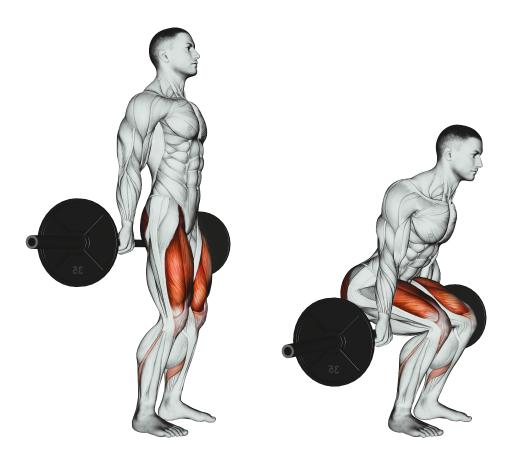
The barbell hack squat is a classic exercise that’s stood the test of time. By positioning the barbell behind the legs, the barbell hack squat challenges your posterior chain in a whole new way. This old-school move is sure to bring further gains and a fresh challenge to your workout.
The Barbell Hack Squat is a compound exercise that targets the quadriceps, hamstrings, and glutes. Here’s how to perform barbell hack squat :
- Setup: Stand straight with a barbell behind you at arm’s length and feet shoulder-width apart.
- Squat Down: Keep your head up and back straight as you squat until your upper thighs are parallel to the floor.
- Lift: Press mainly with the heels of your feet and squeeze your thighs as you go back up while exhaling.
- Repeat: Perform the recommended number of repetitions.
The barbell hack squat exercise is similar to a deadlift but with the barbell positioned behind the legs. It’s great for building strength in the lower body without putting too much load on the spine. Remember to start with a lighter weight to get used to the movement and avoid injury.
Bridge to Better Glutes: Kas Glute Bridge
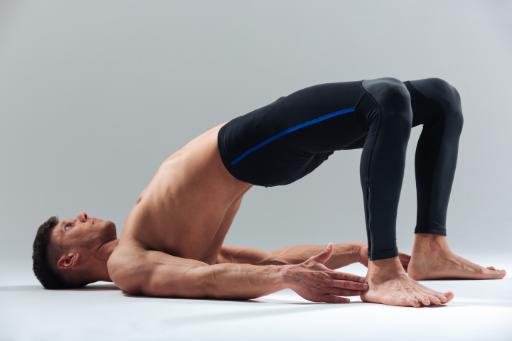
Elevate your glute game with the Kas glute bridge . This exercise targets the glutes, engages the core, and improves hip mobility. It’s a simple yet effective move that can be done anywhere, making it a staple in any leg workout.
The Kas Glute Bridge is a variation of the standard glute bridge exercise, named after Coach Kassem Hanson, who popularized it. It’s similar to a hip thrust but with a shorter range of motion, which isolates the glutes more effectively. Here’s how to perform a Kas Glute Bridge :
- Setup: Position your mid-back against a sturdy bench or box, with your legs straightened if you use a barbell.
- Bar Position: Roll the bar over your hips and hold it with both hands. A barbell pad can be used for comfort.
- Foot Placement: Walk your feet towards your body until your soles are flat on the floor.
- Movement: With your chin tucked and core engaged, drive through your heels to raise your hips toward the ceiling until your knees are at a 90° angle.
- Lowering: Steadily lower your hips by two to three inches without touching the floor.
- Lifting: Squeeze your glutes and drive through your heels to return to the top position.
- Repetition: This is one rep. Repeat for the programmed number of reps before lowering your glutes—and the bar—to the floor.
The main benefit of the Kas Glute Bridge is that it encourages slow and controlled reps, preventing the use of momentum to cheat the weight up, thus providing a focused workout for the glutes.
Nordic Hamstring Curl : The Strengthener
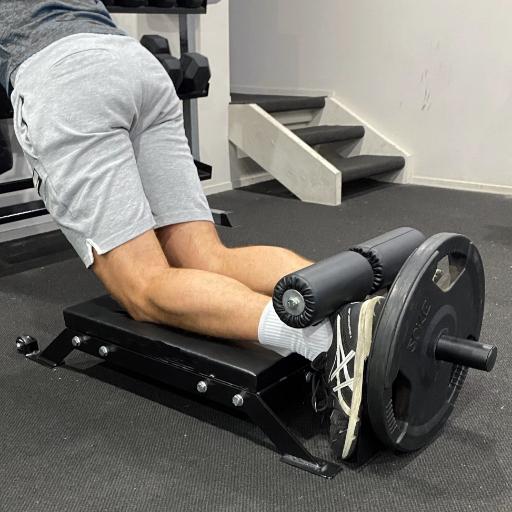
Look no further than the nordic hamstring curl for an intense hamstring workout. This bodyweight exercise is deceptively challenging and incredibly effective at building hamstring strength and preventing injuries.
The Nordic Hamstring Curl is a challenging bodyweight exercise that targets the hamstrings. It’s known for its benefits in increasing hamstring strength and reducing the risk of injury. Here’s how to perform the nordic hamstring curl :
- Setup: Kneel on a mat with your feet secured under a bar or heavy object.
- Starting Position: Keep your body straight from your knees to your shoulders.
- Descent: Slowly lower your torso towards the ground by extending your knees, using your hamstrings to control the movement.
- Ascent: Use your hamstrings to pull yourself back up to the starting position or push off the ground with your hands if necessary.
It’s important to note that the Nordic Hamstring Curl is quite advanced and may require a gradual build-up of strength and technique. It’s highly effective for improving eccentric hamstring strength, which is crucial for sprinting performance and injury prevention.
Seated Leg Curls : The Isolator
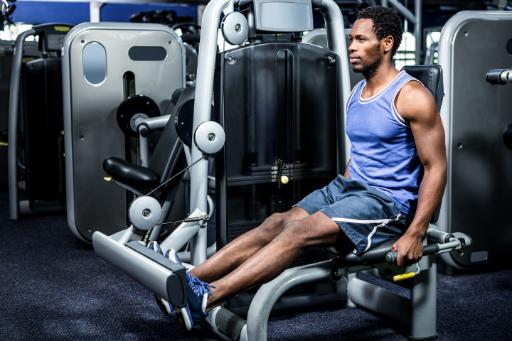
Seated leg curls are perfect for isolating the hamstrings. By focusing solely on the curling motion, you can ensure your hamstrings get the attention they deserve. Seated leg curls are essential exercises for balanced leg development.
The Seated Leg Curls are exercises that primarily target the hamstrings, the muscles responsible for bending your knee. It’s performed using a leg curl machine and is excellent for isolating these muscles. Here’s a step-by-step guide on how to do Seated Leg Curls:
- Position Yourself: Sit on the leg curl machine with your back against the pad.
- Adjust the Pad: Place your lower legs against the padded lever and adjust the lap pad to secure your thighs just above the knees.
- Secure Your Legs: Ensure your legs are levered with the equipment and completely stretched in front of you.
- Perform the Curl: Engage your core and hamstrings to curl the padded lever inward towards your buttocks.
- Maintain Upper Body Stability: Keep your upper body still, with no motion other than your legs.
Control the movement throughout the entire range of motion to keep tension on the hamstrings and avoid using momentum.
Raise the Bar: Seated Dumbbell Calf Raise
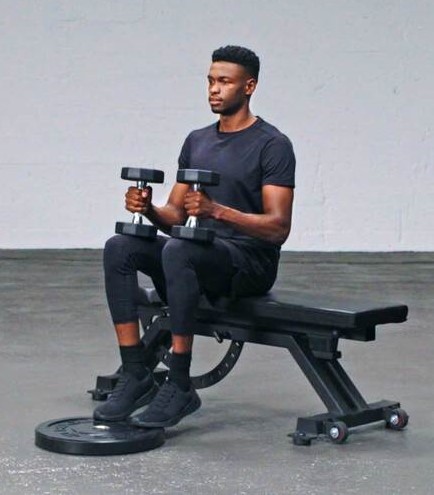
Don’t forget about those calves! The seated dumbbell calf raise is a targeted move that hits the often-neglected calf muscles. With consistent effort, you’ll build strength and definition that will enhance your overall leg aesthetics.
The Seated Dumbbell Calf Raise is an effective exercise for targeting the calf muscles, particularly the soleus muscle. Here’s how to perform the seated dumbbell calf raise exercise:
- Setup: Sit on a bench with your feet flat on the floor.
- Position: Place a block or weight plate in front of you to elevate the balls of your feet.
- Dumbbells: Hold a dumbbell vertically on each knee, securing them with your hands.
- Movement: Lower your heels towards the floor, then push through the balls of your feet to raise your heels as high as possible.
- Squeeze: Make sure to squeeze your calf muscles at the top of the movement.
- Repeat: Perform the desired number of repetitions.
The seated dumbbell calf raise exercise can be done with one leg at a time or both simultaneously. It’s important to maintain control throughout the movement and to avoid bouncing at the bottom.
Conclusion
Incorporating these exercises into your leg workouts will ensure a balanced, comprehensive approach to lower body training. Remember, consistency is key, and proper form is essential. Now, go forth and build the powerful, well-defined legs you’ve always wanted!
